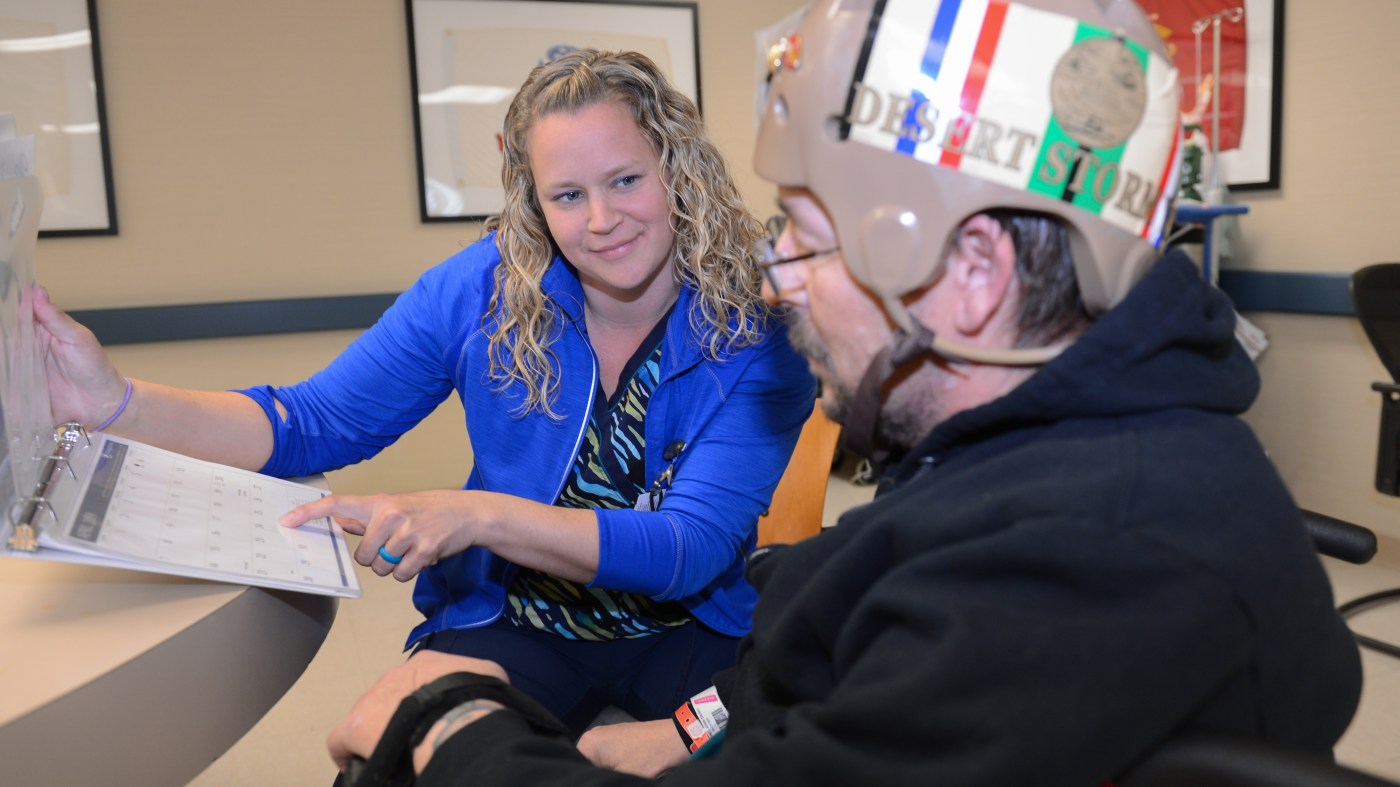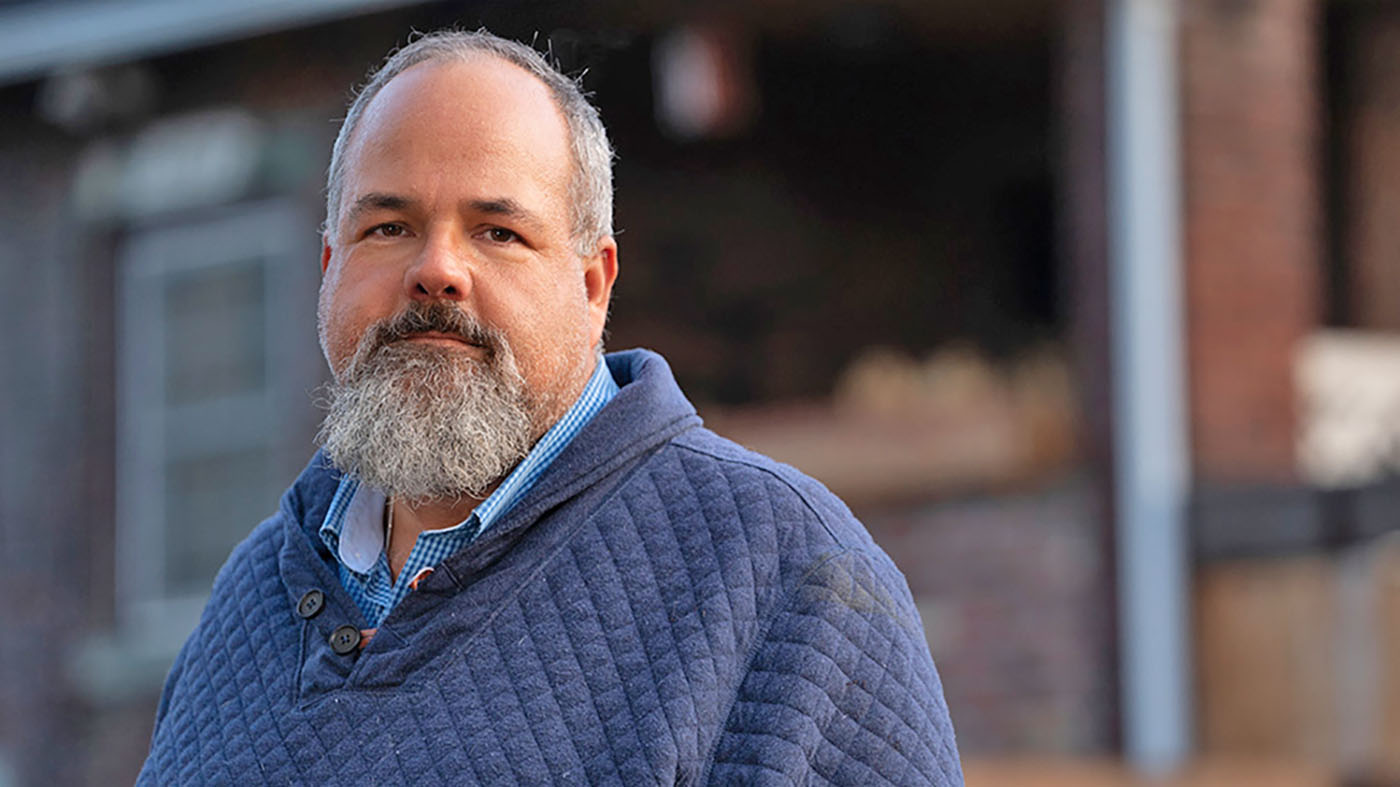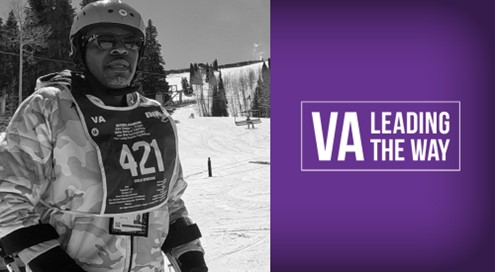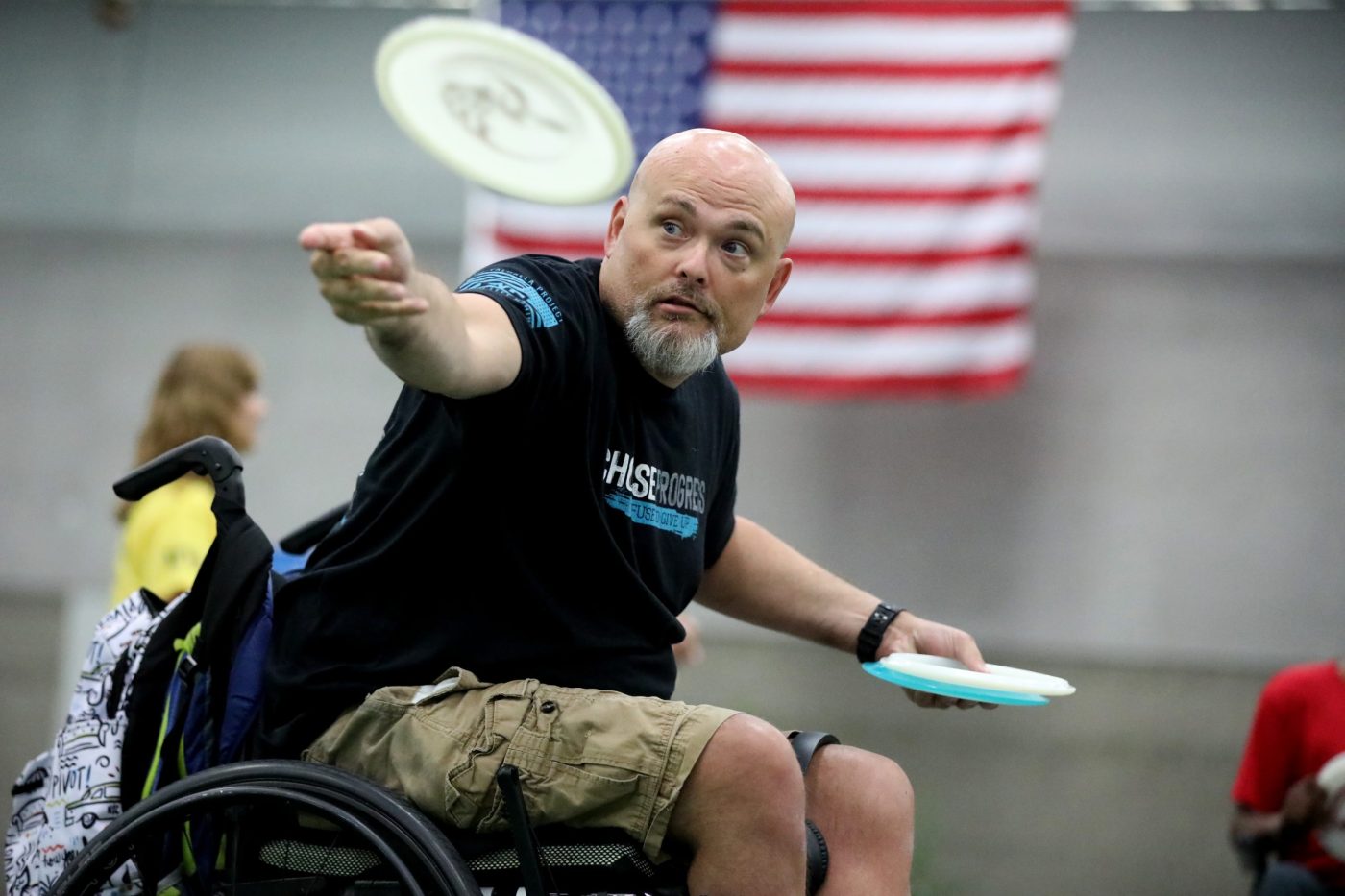
Michelle Patterson helps Air Force Veteran Dan Cleary with coordination and strength skills through a game of air hockey. Dan’s mom said the care her son has gotten is exceptional. (Photo by April Eilers)
Christie Spevacek was eating dinner last year when the man approached her.
“Hey, I know you,” he said. “You’re from my pictures.”
Twelve years earlier, he was a critically injured patient at the Minneapolis VA Medical Center’s polytrauma center, unable to talk or walk. Now he was at the Winter Sports Clinic in Snowmass, Colorado, an annual event for Veterans with amputations, brain, spinal cord and other injuries.
Not only was he walking, talking and skiing, he recognized Spevacek as one of his medical providers during that critical point in his life.
“When you first see people come here, they are injured so severely, just learning to talk again, just learning to walk again, going through a lot of struggles,” said Spevacek, the polytrauma center inpatient nurse case manager. “And then you see something like that at Snowmass, where they may still have deficits, but they are out there doing these things. That’s what makes it worthwhile for all of us.”
This one Veteran wasn’t just the exception. Time and again, Veterans and family members echo those same sentiments.
The Minneapolis VA is one of five regional polytrauma centers of excellence in the United States that treats Veterans throughout Minnesota, as well as North and South Dakota; Nebraska, Iowa, Missouri, Kansas, Wisconsin, Illinois, Indiana and Ohio. And, with a special arrangement with the Department of Defense, the medical center has treated active-duty troops since 2005.
This is where an army of physicians, specialists and nurses, as well as speech, occupational, physical and recreation therapists, psychologists, psychiatrists and other medical professionals intertwine to provide the latest, scientifically backed care unlike anything seen in the civilian community.
In one room, recreation therapist Michelle Patterson massages the right arm of Air Force Veteran Dan Cleary. A few minutes later, she puts a yellow puck in his hand.
“Let’s play this game, Dan,” she says, as he focuses on hitting it to the other side of the air hockey table.
For Cleary, every moment is critical, as the polytrauma team helps him battle back from a massive stroke he suffered at age 37. He can’t speak, but looks intently as people speak with him. Earlier in the week, he worked on dribbling a basketball from his wheelchair and shooting a Nerf gun. He’ll get physical therapy and speech therapy before the day ends.
Tomorrow, he’ll do it all again.
“Everything we do here, it’s constant stimulation and we don’t stop,” Patterson said. “You never know when something is going to connect, and those moments pop up like little ninjas. Family members can be with loved ones around the clock and not see the slow changes, but we do. Even something like moving their lips, that’s a big deal.
“He is here,” Patterson said. “You can tell Dan is with us.”
Downstairs, in the transitional unit, Air Force Tech. Sgt. Jeremy Clyde is in his third week of care, recovering from a car accident where air bags didn’t deploy. After two deployments to Iraq, a deployment to Afghanistan with nine concussions and a few traumatic brain injuries, this accident seemed to cause the most issues, with severe headaches, nausea and memory fog that got progressively worse. Post-traumatic stress and anxiety added to his challenges.

Air Force Tech. Sgt. Jeremy Clyde said after a car accident and multiple traumatic brain injuries, he is getting treated for multiple issues. The Minneapolis VA treats active-duty and Veterans. “I definitely can’t say I’m cured two weeks after being here, but my wife has noticed that I’m taking more of an interest, I’m more present in our FaceTime conversations.” (Photo by April Eilers)
“It was the straw that broke everything,” he said. “I was at the point where I was at rock bottom and on the verge of divorce. I was just separate and not a part of life. I tried other treatments and programs. Every therapist said I should come here and try this.
“I’m saving my relationship being here. That’s what’s most important to me. I definitely can’t say I’m cured two weeks after being here, but my wife has noticed that I’m taking more of an interest, I’m more present in our FaceTime conversations.”
Ward by ward, room by room, it’s something different. In one area, a team helps a patient struggle to relearn how to walk. In another, therapists teach a healthy cooking class. There is healing touch, acupuncture and more.
Outside on the hospital ground’s picnic areas, while some Veterans practice discus, javelin and boccia for the Wheelchair Games, recreation therapist Kristin Powell helps Marine Corps Veteran Olivia Nord get into her recumbent bike.
She takes a few spins around the parking lot while Powell jogs alongside.
“You got this, Olivia!”
— Recreation Therapist Kristin Powell shouts encouragement to 21-year-old Marine Corps Veteran Olivia Nord, who wasn’t expected to survive after a devastating car accident.

Kristin Powell runs alongside Olivia Nord while shouting encouragement to her. The Marine Corps Veteran wasn’t expected to survive a devastating car accident, but is now prepping for the upcoming Summer Sports Clinic in San Diego. (Photo by April Eilers)
In a few months, the 21-year-old will compete at her first-ever Summer Sports Clinic. But less than three years ago, she was a patient in the acute ward, slowly coming out of a month-long coma.
Nord was in a head-on car crash that killed her three friends, and nearly killed her and her mom. She had a torn aorta, lacerated liver, crushed femur and severe brain injury that left her left arm paralyzed.
She spent 14 months here — first as an inpatient and then in the transitional unit. Now she comes back as an outpatient.
“When she was first here, they had a nursing assistant with her 24/7 – every hour, every day, until she came out of her coma,” said her mom, Jenny Nord. “They were always talking to her, braiding her hair, painting her fingernails, helping her draw.”
She had no memory of the accident and had to be constantly reminded why she was in the hospital.
Jenny said: “The very first room she was in, they told us, ‘This is a special room. The patients in this room always make a tremendous recovery.’ Because she was determined, and they were determined to help her, she kept progressing and wouldn’t have recovered without them.”
The polytrauma center is actually made up of different departments that combine care for severe injuries. But the brunt of the work is done with patients like Olivia, those recovering from severe brain trauma.
“We serve pretty exclusively those with brain injuries and strokes, as well as some new amputees and even spinal cord,” said April Cerqua, a senior social worker within polytrauma who helps route patients to the correct level care. “It could be a combination of all those areas. We could realistically treat anything from a concussion to someone in a coma.”

Two strokes in 2015 left Mark Sweeney paralyzed. He is now back in the transitional unit for what he calls a “touch up.” He’s walking and taking care of himself now, but said he had some residual problems, and is back to work on memory and other skills. “They make it so you want to get better,” he said. (Photo by April Eilers)
There is one word that differentiates this place from other hospitals in the community: Time.
“The biggest driving factor for us is making sure the patient is put first, taken care of and given whatever they need,” Cerqua said. “A typical acute rehab unit might keep someone two or three weeks.”
But here, patients can stay six weeks to two months or more in the 18-bed, inpatient area, where round-the-clock care is provided. Once they leave the acute ward, they could stay months longer in the 10-bed transitional unit where patients continue to work toward more independent living and adjust to their new home and community life by working on brain skills and memory strategies, along with other ongoing therapy. This is done through fitness plans and group outings to grocery stores, restaurants and shops. The rooms in this transitional unit are more home-like and less institutional to provide more of a home setting.
“Particularly in the private sector, stays are determined by insurance,” Cerqua added. “But here, we provide the care they need. We are here not just for them, but for their caregivers. We help set them up with ramps and specialty equipment. We help the caregivers to understand how this will affect them and what they can expect.”
Another unique aspect of the care is recreation therapists are part of the immediate care team, engaging even the most traumatically injured patients from the beginning to find something — anything — to promote a connection and healing. The polytrauma team believes this is a major difference from private care and gives these patients another edge in their recovery.
“I saw a patient come here in a coma, with a severe brain injury. He’s now back to work, back to coaching youth sports,” Spevacek said. “This job can be so tough, and it is especially tough and draining for the families. Nothing is more rewarding than seeing one of our patients walk for the first time, watching them get up and talk and eat. It’s the simple things we take for granted which are so amazing for us.”
Jack Avery, the extended care and rehabilitation accreditation coordinator, walks around the center to point out areas that have changed, as the Minneapolis mission took on active-duty patients. There are posters on the wall with military themes and the five flags representing the Navy, Marine Corps, Army, Air Force and Coast Guard.
“Nothing is more rewarding than seeing one of our patients walk for the first time, watching them get up and talk and eat. It’s the simple things we take for granted which are so amazing for us.”
— Christie Spevacek, talking about some of the incredible recoveries they’ve seen at the Minneapolis VA
“Prior to our recent military conflicts, we were mostly focused on geriatric care, but that changed our age cohort,” Avery said. “Now it’s not unusual to see patients who are 19, 20 or 21 years old. They’re newly married and have different life roles.
“That created a cultural transformation for us, where we now have therapists who also focus on marriage and family therapy, and how a brain injury will affect that dynamic when they go home. With the younger generation, we also have seen more use of smartphones and computers, which helps people to set alarms and can help teach other skills.”
That transformation and spectrum of care is evident across the center. On the transitional unit, Mark Sweeney, 64, is back for what he calls a “touch up.” Two strokes in 2015 left him paralyzed on his left side. He’s walking and taking care of himself now, but said he had some residual problems, and is back to work on memory and other skills.

Golf pro gives tips to retired Army Maj. Toni Muckala in the golf simulator, located in the basement of the Minneapolis VA. Therapists use the golf simulator as part of therapy and recovery. (Photo by April Eilers)
“They make it comfortable here and make it so you want to get better,” he said.
Upstairs in the acute ward, Cleary’s mom takes care of daily visits with her son. His wife, Jessica, takes care of their two young children in Michigan. A few days later, she’ll fly to the medical center and stay at the Fisher House on campus so the Cleary family can celebrate his 6-year-old daughter’s birthday. Cleary helped wrap birthday presents as part of his therapy.
There is a washer and dryer in another area, not just so patients can have real clothes and feel they aren’t stuck in a hospital setting, but as part of their recovery. Everything from separating laundry to pouring the right amount of detergent helps with hand therapy and strength recovery while retraining the mind and memory.
There is even an apartment located directly in the polytrauma center where families can stay for a couple days before going home.
“For many of our patients, even with recovery, there is a lot they may have to get used to,” Avery said. “Things will be different around the house. The apartment gives them a chance to experience that here and work through some of those issues. It could be something as simple as learning how to make coffee again.”
Soon, the day will end here. Most people in their offices will go home. The physicians, nurses and specialists will still keep their watch around the clock of their most critical patients. Tomorrow morning, the hospital will fill with activity again. And again, these patients will go through all the intensive care and therapy again.
And again.
And little things happen that turn into big things.
“If I had to sum it up in one word, it would be ‘Resilience,’” Patterson said. “I have seen recoveries here that continue long after they leave the hospital, and when they come back to visit, and they are determined and resilient.
“I spent the better part of 25 years working with kids, and making the leap from working with kids to working with Veterans, I didn’t know if I would be able to succeed or love it like I did with kids. I feel like I am blessed. I feel like I’m in the right place.
“It’s why I come to work every day.”
And tomorrow she’ll be back, along with the others. And the day after that. And after that day, too.
The outcomes aren’t promised. But to the employees here, they don’t focus on the promise. They look toward the possibility.
Topics in this story
More Stories
Be ready before a suicide crisis by learning about resources that are available. You don’t have to face it alone.
Army Veteran John Wade participated in the 38th annual National Disabled Veterans Winter Sports Clinic, continuing to live his life to the fullest.
Veterans and volunteers interested in registering online for the 43rd National Veterans Wheelchair Games (NVWG) can do so now through April 5, 2024.







polytrauma? It looks like Nicky Hayden get after an accident, which took his life.
This is what we a crave for as a citizen. Optimum Protection.